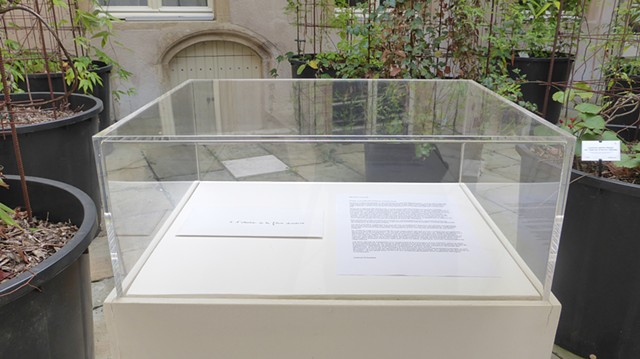Médiation Culturelle
Project Statement (exhibited in French in the vitrine in the courtyard outside the exhibition)
Sometimes it is not enough to exhibit something.
The FRAC Lorraine is both a workplace and the host of this exhibition. The FRAC promotes political positions through the exhibitions it makes, the educational programs it organizes, and the artists whose work it collects. However, the labour conditions internal to the institution are not consistent with the political positions it outwardly proclaims.
Through research I found that the médiatrices, who work at the FRAC Lorraine to open the artwork to the public, are not actually employees of the FRAC Lorraine. They are employed through a subcontract with a third party private agency (a situation that is apparently quite common in cultural centres throughout France). As a result of the mediation of their employment, they are not able to address concerns directly with the FRAC Lorraine, but must instead petition the agency to change their working conditions. This agency is a corporation designed to profit from positioning young female bodies to adorn the entrances of cultural events. This corporation is not a contemporary art structure, and does not consider the level of engagement, reflection, and continuous self-education involved in the task of the médiatrices.
Not only does this structural intrusion of neoliberalism produce frictions between the médiatrices and the internal staff, it also contradicts the outwardly feminist mandate and agenda of the institution.
I wrote a letter suggesting certain structural changes to the status of the médiatrices be realized as my artwork. My intention was for these changes, incorporated into the administrative documents, contracts, and pay-slips, to be at once a symbolic artwork and a political action.
A major obstacle to pursuing any negotiations is that the FRAC Lorraine is currently in transition and has been without a director for over a year. While there have been efforts to develop a more horizontal structure in the absence of a director, it seems that any shifts in employment status, even semiotic ones, are on hold until the arrival of a new director. The current person responsible indicated that the changes that I proposed might take place on their own upon the appointment of the new director, and that an explosive public denunciation, such as she found my letter to be, might actually jeopardize these negotiations.
I have decided therefore to defer the conclusion of my project until a new director is appointed. The accompanying letter appeals to the incoming director to address the problems s/he has inherited from the previous direction, specifically concerning the employment status and conditions of the médiatrices, and to do so in pursuit of the conclusion of my artwork. Nonetheless, the choice to subordinate these decisions to hierarchical power structures comes at the cost of a hope for more horizontal decision-making process to be achieved in the absence of a director and in greater alignment with the proclaimed feminist position of the institution.
